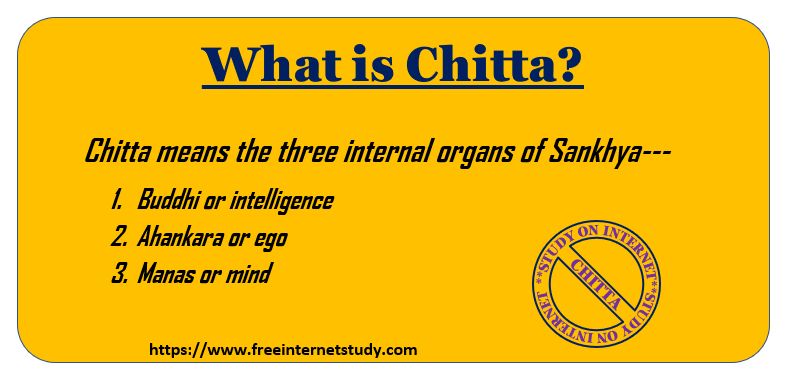What is Chitta | Chitta in Yoga Meditation: Chitta is the same as antahkarana. It is mahat or buddhi which includes ahankara and manas.
What is Chitta | Chitta in Yoga Meditation
Chitta
Page Contents
MEANING OF CHITTA :
Chitta means the three internal organs of Sankhya—
- Buddhi or intelligence
- Ahankara or ego
- Manas or mind
Chitta is the same as antahkarana. It is mahat or buddhi which includes ahankara and manas.
Chitta is the first evolute of Prakrti and has the predominance of sattva. It is in itself unconscious.
But being finest and nearest to Purusa, it is conscious. When it gets reflect the Purusa and therefore appears as if it is conscious.
When it is gets related to any object, it assumes the ‘form’ of that object. This form is called Vritti or modification.
The light of consciousness which comes from the Purusa and illuminates this ‘form’ is called ‘jnana’.
Purusa is essentially pure consciousness and is free from the limitations of the spirit. Just as in a red-hot iron ball, formless fire appears spherical and cold iron appears hot, similarly on account of its reflection in the Chitta , Purusa appears changing and Chitta appears conscious.
Just aa the moon appears as moving when seen reflected in the moving waves , and waves appears as luminous , similarly Purusa appears as undergoing modifications and Chitta appears as conscious due to Purusa’s reflection in it.
When the Purusa realize that it is completely isolated and is only a passive spectator, beyond and play of prakrti it ceases to identify itself with its reflection in their Chitta with the result that the light is withdrawn and the modification of the Chitta fall to the ground.
This cessation of the modification of the Chitta through meditation is called ‘Yoga’ . It is the return of the Purusa to its original perfection .
KINDS OF CHITTA :
The modification of the chitta are of five kinds —
- Right cognition (Pramana)
- Wrong cognition ( viparyaya)
- Verbal cognition or imagination (vikalpa)
- Absense of cognition or sleep (nidra) and ,
- Memory (smrti)
1 . RIGHT COGNITION: Right cognitions is of three kinds :
- PERCEPTION (PRATYAKSHA) : When the chitta though the sense organs comes into contact with the external object and assumes its form or comes into contacts with the internal mental state.
- INFERENCE (ANUMANA) : When the chitta cognizes the generic nature of things . And ,
- VERBAL TESTIMONY (SHABDA) .
Viparyaya is positively wrong knowledge like that of a rope-snake. Vikalpa is mere verbal cognition like that of a hare’s horn .
Nidra is called absence of cognition , yet it is a mental modification because after sleep a persons says ‘ I slept sound and knew nothing ’ and therefore there must be some mental modification of past experience to support this absence of knowledge .
Smrti is the recollection of past experience through the impressions left behind .
In fact the Purusa is the eternally pure and transcendental consciousness .
It is the Chitta with the reflection of the Purusa in it or the Purusa as reflected in the Chitta , which is the phenomental ego or Jiva , which is subject to birth and death and transmigration and to all painful or pleasurable experience, and which imagines itself as the agent and the enjoyer .
There are five kinds of sufferings (klesha) to which it is subject, These are :
- Ignorence (avidya)
- Egoism (asmita)
- Attachment (raga)
- Aversion (dvesa) and ,
- Clinging to life and instinctive fear of death (abhinivesha) .
The bondage of the self is due to its wrong identification with the mental modification through proper discrimination between Purusa and Prakrti and the consequent cessation of the mental modifications. It is the aim of Yoga to bring about this result.
There are five levels of mental life (chittabhumi) :
The differences in the levels are due to the predominance of the different gunas.
- The lowest level is called Ksipta or restless, because the mind here is restless due to the excess of rajas and is tossed about like a shuttlecock between different sense-objects .
- The second is called Mudha or torpid. The mind here has the predominance of tamas and tends towards ignorance, sleep and lethargy.
- The third is called Viksipta or distracted. Here sattva predominates, but rajas also asserts itself at times ( viksipta here doest mean ‘extremely restless’ as its name suggests but ‘ better than ksipta’ because in ksipta rajas predominate while in viksipta sattva predominates ) .
- The forth is called Ekagra or concentrated. The mind here is entirely dominated by sattva, and rajas and tamas are subdued. The mind becomes concentrated or the objects of meditations.
- The fifth and the highest level is called Niruddha or restricted. Here the mental modifications are arrested, thought their latent impressions remain.
************If you like this article then please share it with your friends in social media*****************
Find more references click here
Also read the following articles——————-
The Administrative Structure of Public Administration
Importance of Education Paragraph: Education in Life
What is Democracy: Concept and Meaning
Basic Features of The Indian Constitution

